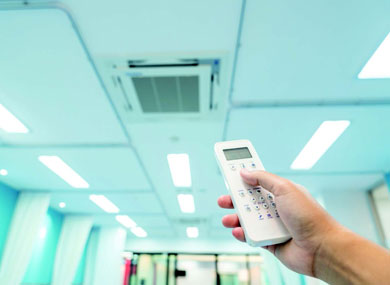A review of Australia’s key guide to indoor air quality in buildings represents a long overdue chance to address a problem area that is putting people’s lives at risk.
By Cameron Cooper
COVID-19 has put indoor air quality (IAQ)-once treated as an afterthought by some in the construction sector- clearly on the radar.
An understanding that the SARS-CoV-2 virus spreads through airborne transmission has heightened awareness of the importance of IAQ, prompting calls for better rules and regulations around ventilation in buildings such as hospitals, schools and hospitality venues.
The Australian Building Codes Board (ABCB) has embarked on a review and update of its Indoor Air Quality Handbook, with a consultation period ending in September 2022.
First created in 2016, the handbook is designed to help practitioners with the design, construction and certification of new buildings when using the IAQ verification methods. As a result of COVID-19, the ABCB has agreed to the handbook update.
Geoff Hanmer, managing director of architectural company ARINA and adjunct professor of architecture at the University of Adelaide, hopes lessons from the pandemic will inform a revised handbook that better reflects the latest scientific evidence on IAQ.
“Everywhere I go around Australia people are now very conscious of keeping doors and windows open, which they weren’t before, so there’s certainly an increased awareness of IAQ,” he says.
The key now is to turn that awareness into change.
Code concerns
The National Construction Code (NCC), which the ABCB updates and maintains, is an important element in setting mandatory performance requirements for ventilation in buildings.
COVID-19 has driven home why this is so critical, with the virus having claimed between 17 million and 25 million lives worldwide, according to The Economist. Most transmission has occurred indoors, and Hanmer says better ventilation and high-efficiency particulate air (HEPA) filtration could have prevented many of those deaths.
He has expressed concerns about what he sees as anomalies with the NCC, noting that nightclubs and schools, for example, can cater for hundreds of people without having any requirements for appropriate ventilation. Under ‘deemed to satisfy’ air-quality requirements, the NCC calls for buildings to either provide ‘natural ventilation’ using openable windows measuring five per cent of the floor area, or ‘mechanical ventilation’ such as air-conditioning that complies with Australian Standard 1668.2. However, Hanmer points out that no law or regulation prevents the construction of a naturally ventilated building that is operated with its windows shut.
“People confuse moving air with ventilation and, of course, the two things aren’t the same. So, you can feel comfortable in an air-conditioned room, but you can actually be in a soup of people’s exhaled air which can be full of pathogens.”
He is also critical of the fact that, in mechanically ventilated hospitals designed in accordance with AS 1668.2, nothing prevents the air that is supplied to patient rooms returning to air handling units via corridors, potentially exposing patients, healthcare workers and the public to “airborne effluent”.
Such scenarios are a far cry from the start of the 20th century and before World War II, according to Hanmer, when people “took seriously” the need for ventilation in buildings for health reasons. At the time, there was a growing sense that tuberculosis was spread via inhalation of small particle aerosols, a theory that later proved to be correct.
“That focus on ventilation was strong until about the time of World War II. After that, with the advent of penicillin and the use of antibiotics to control infections, including TB, some of this dropped away. But we’ve been brought back to reality with a bump, which is that most respiratory and some other diseases are airborne.” This includes measles and COVID-19.
What should change
Hanmer has a number of recommendations that he believes the handbook, in tandem with the NCC, should address, including:
- establishing a national set of standards for IAQ. He notes that under the NCC, if someone constructs a deemed-to-satisfy mechanically ventilated building, there is a requirement to control pathogens. “But in the handbook, it says there are no standards to do this and no way of measuring pathogens. So, they just give up.”
- insisting on provisions that would ensure indoor air is free from particulates, carcinogenic gases such as nitrogen oxide and benzine, pathogens such as bacteria, mould and fungal spores; or viruses such as COVID-19. These provisions should progressively apply to all buildings accessed by the public.
- ensuring ventilation is sufficient for gaseous contaminants generated by building contents and indoor activities to stay at safe levels.
- addressing waterproofing issues in buildings. Hanmer says Section F of the NCC does not adequately control waterproofing, resulting in many buildings from Sydney through to northern Queensland supporting biological growth, including black mould. “Black mould spores are really bad for you, and again the code doesn’t do anything about it.”
- setting requirements to ventilate common spaces. In Class 2 buildings, common spaces including foyers, corridors and stairways are not required to be ventilated under the current NCC. Hanmer says this has caused clusters of COVID-19 infections as residents pass through compromised common spaces.
- encouraging the display of CO2 levels in buildings such as restaurants and pubs. The use of wall-mounted measuring devices for air quality could inform patrons of poor air quality. “It would keep people aware that they’re safe, if they’re safe, and it would keep the cafe owners on their toes with regard to getting ventilation right.”
A chance to get it right
In addition to hospital and healthcare facilities, Hanmer is especially worried that most state and low-fee schools operate in buildings in which heating, ventilation and air-conditioning systems simply recirculate air, or pollute it. Teachers and students deserve better. He says the update of the Indoor Air Quality Handbook is an opportunity for the ABCB to start reforming the NCC and ensure that it takes health issues into proper account.
“The handbook is fl awed on a number of levels, but in my view some of the recommendations of the handbook should be straight out incorporated in the NCC. There’s no doubt that it’s beyond time that we had a national set of standards for IAQ.”






